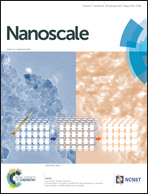Morphology-controlled In2O3 nanostructures enhance the performance of photoelectrochemical water oxidation†
Abstract
Nanotower- and nanowall-like indium oxide structures were grown directly on fluorine-doped tin oxide (FTO)/In2O3 seeded substrates and pristine FTO substrates, respectively, by a straightforward solvothermal method. The tower-like nanostructures are proposed to form via a self-assembly process on the In2O3 seeds. The wall-like nanostructures are proposed to form via epitaxial growth from the exposed edges of SnO2 crystals of the FTO substrate. The nanotowers and nanowalls are composed of highly crystalline and ordered nanocrystals with preferred orientations in the [111] and [110] directions, respectively. The two structures display remarkably different activities when used as photoanodes in solar light-driven water splitting. X-ray photoelectron spectroscopy results suggest an increased density of hydroxyl groups in the nanowalls, which results in a decrease of the work function and a concomitant shift in the onset potential of the photocurrent in the linear sweep voltammograms, which is further confirmed by Mott–Schottky and flat-band potential measurements, indicating the importance of hydroxyl content in determining the photoelectrochemical properties of the films. Morphology-controlled, nanostructured transparent conducting oxide electrodes of the kind described in this paper are envisioned to provide valuable platforms for supporting catalysts and co-catalysts that are intentionally tailored for efficient light-assisted oxidation of water and reduction of carbon dioxide.


 Please wait while we load your content...
Please wait while we load your content...